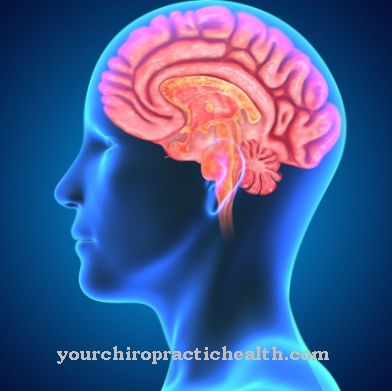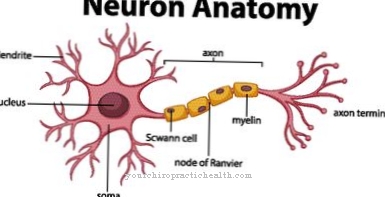At a Visual field loss (hemianopia) there is a limitation of spatial vision. The field of vision is the area that is recognized when looking when the immobile eyes are directed forward.
What is visual field loss?

Normal vision is impaired when the visual field is impaired. For the normal field of vision, sharp vision in the central area and rather blurred contours on the left and right edges are characteristic. However, movements can still be perceived in the peripheral areas.
Visual field defects can be unilateral (monocular hemianopia) or affect both eyes (binocular hemianopia). In addition, there are visual field deficits that limit vision at close range (“central” hemianopsia) and those that affect distance vision (peripheral hemianopsia).
The healthy long-range field of vision enables the temple to see up to 90 degrees to the left and right, up to 70 degrees down and up and up to 60 degrees in the direction of the nose. Over the course of life, the field of vision deteriorates as the normal aging process progresses. However, the field of vision can also be individually developed differently due to habituation factors. Furthermore, the color, brightness and size of the viewed objects influence the field of view.
If an island-shaped area is no longer recognized within the field of vision, a so-called "scotoma" is present. With a “concentric” partial loss of the visual field, the outer visual areas are restricted. Image distortions are present in metamorphopsia. In a hemianopia, the field of vision is left or right half-sided. There is also the possibility of a quadrant anopia, in which a quarter of the visual area is affected by a visual field loss (quadrant loss).
causes
A visual field loss can occur as a result of diseases of the eye or the brain. Possible diseases leading to a hermianopia include pathological changes in the visual pathway, the optic nerve junction (chiasma opticum), the optic nerve pathways and the visual centers located in the visual cortex and brain.
Retinopathy is when the retina is damaged. The age-related macular degeneration, which usually only occurs from the age of 60, only leads to an impairment of the central vision. The cataract (cataract), which if left untreated, can lead to blindness, is caused by clouding of the eye lens. Glaucoma (glaucoma) is caused by an increase in pressure in the eye, which can damage the optic nerve.
Eye and head injuries of all kinds as well as migraines can also lead to visual field loss. A hermianopia can be triggered by bleeding in the brain, by a stroke (apoplexy) or by the widening of an arterial blood vessel (aneurysm) in the brain. Tumors in the brain can also cause a loss of visual field.
You can find your medication here
➔ Medicines for visual disturbances and eye problemsDiseases with this symptom
- Cataract
- stroke
- Aneurysm
- Blindness
- Cerebral hemorrhage
- Age-related macular degeneration
- Glaucoma (green star)
- migraine
- thrombosis
Diagnosis & course
Visual field loss is diagnosed by a neurologist or an ophthalmologist. In so-called perimetry (visual field examination), the patient looks at a luminous point with one eye or both eyes and indicates the point in time from which he perceives a presented object. The patient's ability to perceive can thus be compared with the visual field of healthy people.
One of the different methods of visual field diagnosis is the "contra-controntation test" ("parallel test"), in which the doctor and patient sit opposite each other and each cover one eye while an object to be observed is brought up. If the visual fields of the doctor and patient differ from one another, it may be possible to conclude that there is a loss of visual field. In the so-called kinetic perimetry, which is also a confontation test, a luminous point to be observed is brought up.
With the often used "automatic static perimetry", the light sensitivity of the retina is measured at certain points. Light points appearing in different sequences are confirmed by the patient after they have been recognized by pressing a signal button. Unrecognized luminous dots indicate a loss of the visual field.
If certain diseases are the cause of the visual field loss, a blood test may be carried out. X-ray examinations as well as computer or magnetic resonance tomography as well as angiography (blood vessel examination after administration of contrast media) can be used in the case of visual field failure.
Complications
In defining the complication, one must consider the health disorder to be blamed. A complication is a consequence of a disease or an undesirable side effect of a drug that has been used against the disorder in question. In this respect, complications can arise as a result of overlooking a condition and as part of treatment.
A visual field loss is the complication of glaucoma that occurs in advanced cases, which is one of the disorders of the eye and thus the sensory organs. Visual field defects could also cause further complications such as, in the worst case, blindness in the affected eye. Visual field loss is caused by damage to the optic nerve as a result of constantly increased eye pressure. Complications are more common in smokers or elderly people. Visual field defects are initially not noticed when the healthy eye compensates for the defect. To avoid serious complications, an ophthalmological examination should be carried out if visual disturbances occur.
Occasionally, in acute cases, the person concerned should be treated in the clinic and, if necessary, operated on to avoid further complications such as blindness. After that, the plan for outpatient treatment against the underlying disease can be made. A diet that promotes blood circulation, omitting nicotine and preventing diabetes, as well as routine health check-ups, visual field measurements, and eye tests can often prevent visual field loss. Various drugs, for example antidepressants, can trigger glaucoma and should therefore be selected carefully.
When should you go to the doctor?
If the visual field is defective, there is a disorder somewhere along the path of the optic nerve between the retina and the visual center in the brain. This can also be on the retina itself. It is true that overexertion of the eyes can lead to a temporary loss of visual field. Nevertheless, it is strongly recommended that you consult a doctor immediately in the event of visual field loss: an ophthalmologist or a neurologist.
Damage to the eyeball itself can lead to a loss of visual field, such as damage to the retina, age-related macular degeneration, eye injuries, bleeding in or in the eyes, and cataracts or glaucoma. The treatment here is, among other things, about preventing impending blindness and generally preserving eyesight as best as possible.
In addition to such eye diseases, visual field loss can also be due to a migraine attack or stroke, as well as a brain tumor or brain aneurysm. A visual field loss can also be the result of an accident with severe head injury. In the case of visual field loss, the underlying disease determines the therapy. If the restoration of the previous vision is not possible or only possible to a limited extent, the doctor will endeavor to work out solutions with his patient to compensate for the impairment as well as possible.
Doctors & therapists in your area
Treatment & Therapy
The underlying disease leading to a loss of visual field determines the therapy. Possible measures are e.g. B. the prescription of visual aids or medication, but also neurosurgical interventions.
Often, however, visual field losses cannot be reversed, so that a restorative therapy is not possible. In the case of age-related visual field deficits such as macular degeneration, treatment attempts often lead to the desired success.
In the case of cataracts, the clouded lens is removed. As a rule, glaucoma is initially treated conservatively with eye drops, but possibly also with laser therapy. Often this does not lead to a lasting reduction in intraocular pressure, so that the pressure-releasing eye water must be surgically drained.
As an immediate measure in the event of an acute increase in intraocular pressure, drugs are administered before an operation is carried out immediately afterwards.
In the event of sudden events (such as a stroke or cerebral haemorrhage caused by external violence) that lead to a visual field loss, the visual field loss that has occurred may regress again with early treatment. In the event of a stroke, an attempt is made to dissolve any blood clots in the brain by administering medication (thrombolysis).
Medicines are also given that inhibit blood clotting so that blood vessels do not become clogged any further. Cerebral haemorrhages require immediate surgery. Aneurysms, which can also lead to a loss of visual field, may be treated conservatively with antihypertensive drugs or surgically.
Outlook & forecast
A common cause of visual field loss is retinopathy, damage to the retina that occurs from age 60 onwards. If left untreated, this impairment of the central vision leads to cataracts due to clouding of the lens of the eye. Glaucoma is known as glaucoma and is due to increased pressure in the eye. The optic nerve is damaged and in the worst case the patient becomes blind.
The forecasts are different. Depending on how far the visual field loss has progressed, countermeasures range from medication to visual aids to neurosurgical interventions. In many cases, the visual field loss cannot be reversed. In the case of age-related retinal damage (macular degeneration), therapy successes are often not as desired.
Patients suffering from cataracts or glaucoma usually have a positive prognosis, because these visual disturbances can often be successfully treated by removing the cloudy lens or by giving eye drops to reduce intraocular pressure. Laser therapy also increases the chances of recovery. In the case of an acute increase in intraocular pressure, the prospects for the further course of the disease are positive, as the therapy is carried out with drugs and a subsequent operation.
Sudden events such as a stroke, head trauma, cerebral haemorrhage or aneurysm can also cause visual field loss. In these acute cases, the prognosis depends on prompt treatment, because the sooner countermeasures are taken, the better the chances of recovery.
You can find your medication here
➔ Medicines for visual disturbances and eye problemsprevention
Preventive measures are not possible in the case of facial rock failure due to age or cataracts. The risk of visual field loss in the form of a glaucoma can be limited by regularly measuring the intraocular pressure, especially after the administration of cortisone medication and after injuries.
Aneurysms can partly be avoided by not consuming nicotine and by avoiding excessive alcohol consumption that increases blood pressure. Cholesterol levels that are too high and being overweight also increase the risk of aneurysm or stroke failure, while exercise reduces the risk of visual field loss.
You can do that yourself
The visual field loss, also known as a scotoma, is a symptom in which the visual acuity is clearly or partially lost. In the worst case, this can lead to complete blindness. In any case of visual field loss, the doctor must be consulted immediately. This is especially true if this is the first or acute failure, it increases significantly, the perception is limited to small outlines or accompanying symptoms such as nausea and headaches are associated with it.
Unfortunately, it is very seldom possible to treat a scotoma and to take personal measures, which makes it all the more difficult. The reason for this is that it is an irreversible disease, so the symptoms can only be slightly weakened. Taking medication or using low vision aids can prevent the scotoma from getting worse.
Furthermore, measures can be taken to make everyday life with the scotoma easier. This includes the enlargement of keypads and fonts on screens, voice-controlled devices, programs that enable articles and books to be read aloud as well as magnifying glasses in the case of visual and reading difficulties.
It is therefore important to avoid further complications and difficulties in everyday life under any condition; the measures mentioned are intended to help. In the case of eye pain and physical discomfort associated with the visual field loss, only pain-relieving medication can be taken.

.jpg)

























